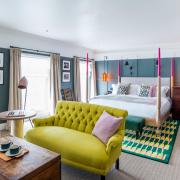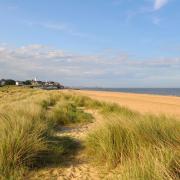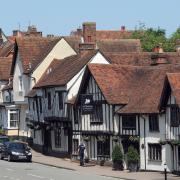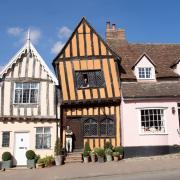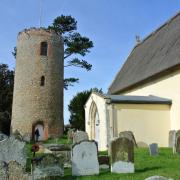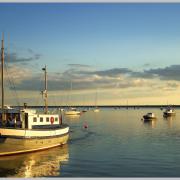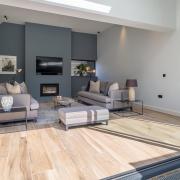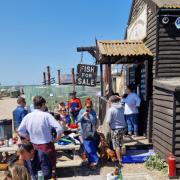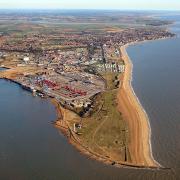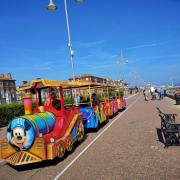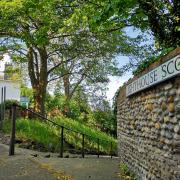Suffolk certainly has its fair share of beautiful buildings, each of which with a rich history or ultra-modern sensibility; here are 9 that you should visit.
Don't forget to let us know what your favourite Suffolk building is or if you think we missed an architectural wonder, be sure to share it in the comments section.
Lavenham Guildhall
Lavenham Guildhall is a stunning Grade-I listed property, and it is one of Britain's finest examples of historic timber-framed buildings from the 16th century. It was built in 1529 by the Guild of Corpus Christi during a boom in the woollen cloth trade.
After the decline in the woollen cloth trade, the guildhall took on roles as a bridewell or a jail, a victorian era workhouse, and during the second world war, it was a social club for American soldiers before becoming a restaurant. In 1946 the Guildhall was gifted to the people of Lavenham, and it came under the care of the National Trust in 1951, where it remains to this day as a museum charting the fascinating history of the building and Lavenham in general.
The House in the Clouds

The House in the Clouds is a rather quirky property and one of the country's most famous examples of follies. It can be seen hovering above the trees from across the peaceful mere and features alongside the Thorpeness Windmill in the village sign.
The House in the Clouds was built in 1923 originally to serve as a water tower; it was cleverly designed to blend in more with the quaint Tudor and Jacobean buildings in the village. Later in 1979, the water tank was removed, and the property was converted into a house which now is a popular holiday rental.
Blythburgh Holy Trinity Church
Fondly referred to as the Cathedral in the Marshes, the Holy Trinity Church in the sleepy village of Blythburgh is an architectural marvel. Unsurprisingly this beautiful and ornate church filled with stunning historical features is a Grade I listed building.
There has been a church at the site in Blythburgh since the Anglo Saxons in around 630; it was rebuilt in the 15th century during a boom of prosperity.
However, during the great storm of August 1577, the church was hit by lightning. It was said to have 'cleft the door, and returning to the steeple, rent the timber, brake the chimes, and fled towards Bongay, six miles off,' - for many, it was perhaps the work of the devil as there appeared to be scorch marks on the Great North Door (still visible today) that resemble the fingerprints of Satan!
The damage from the storm remained for a couple of hundred years, as it wasn't until the later part of the 19th century that restoration work was started on the dilapidated church before it reopened in 1884.
The Balancing Barn

The Balancing Barn is a striking property designed by MVRDV, an award-winning architecture firm based in Rotterdam, the Netherlands.
What makes this barn so unique is that it is clad in a reflective outer shell, and 50% of the property is suspended in mid-air due to an ingenious cantilever method. Architecture lovers can rejoice as the property is available to rent for up to 8 people.
Somerleyton Hall
Somerleyton has been the site of a settlement since the Vikings came ashore; the building we see now as Somerleyton Hall has undergone vast changes over the years.
First, there was a manor house originally built in the Tudor era by the Jernigans; next came John Wentworth, and with him, Somerleyton was transformed into a grand Jacobean mansion complete with beautiful Dutch gables and decadent pleasure gardens.
In the 1840s, at the behest of owner Sir Samuel Morton Peto, renowned architect and sculptor John Thomas transformed the property into what we see today, a gorgeously ornate house in the Italianate style.
Willis Building
An extraordinary example of early 'high-tech' or structural expressionism architecture style, the Willis Building was designed by Norman Foster and Wendy Foster in the 1970s. It has become something of an iconic structure for Ipswich, and this was cemented in 1991 when it became the youngest Grade I listed building status in Britain as it was under 30 years old at the time.

After dark, the smoky reflective glass of the building becomes a vibrant landscape of light (sometimes of varying colours) and showcases the intriguing structure of the interior offices. There used to be a swimming pool in the building for employees to use, but it was covered though not removed due to the building listing status.
Willy Lott's Cottage

Immortalised on canvas in the 1821 painting The Hay Wain by John Constable, Willy Lott's Cottage has become an enduring image of the perfect countryside abode.
Parts of the building date back to the 16th century and 17th century, and after a resurgence in interest in the romantic painter's work in the 1920s, the property that had been descending into quite significant disrepair was restored so that people could visit the beautiful cottage in Constable's work.
Enjoy a gorgeous circular stroll around Flatford and Dedham.
Elveden Hall
Elveden Hall is a beautiful Grade II* listed building in the Italianate style that has a rather storied history and is one of the most magnificent examples of Mughal interiors in England. It is no surprise that the property intrigued filmmakers like Stanley Kubrick, who famously filmed scenes of his final film, Eyes Wide Shut, inside the building.
In 1849 Maharajah Duleep Singh, the last leader of the Sikh Empire, was deposed at the age of 10 after the British East India Company defeated his kingdom in the Second Anglo-Sikh War. The Maharajah was sent to England in 1954 to live in exile; he lived in several different locations in both England and Scotland between a grand hunting tour of Europe and the Balkans with his close friend Sir Samuel White Baker.
Years later, in 1863, 25-year-old Maharajah Duleep Singh purchased Elveden Hall and the surrounding 17,000 acres that made up the estate. He restored many properties in the area and remodelled the main hall to have a magnificent interior that resembled the Mughal palaces of his youth.
The Maharajah became famous among the aristocracy for his shooting parties at the estate, some of which Queen Victoria, Prince George and other high-profile royals would have attended.
Cockfield Windmill
According to historical records, Cockfield Windmill, or The Windmill Suffolk, was the last windmill to be built in the county. Built in 1891, it served to replace Pepper Mill, which had occupied the same location however, this new mill only operated until 1900, and for much of the next few decades, it was used as a store with its cap being removed in the 1920s.
The windmill got a new lease on life when the current owners, Natalie and Steve Roberts, decided to renovate the declining structure and turned it into a unique take on its original state. The windmill is now a beautiful and elegant rental property that sleeps up to 4 people.
Read more of the best Suffolk content here:
5 of the best Afternoon Teas on the Suffolk coast
20 things to do in Suffolk that you may not know about
Where are the 'secret' tunnels and mines under Bury St Edmunds?





